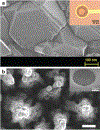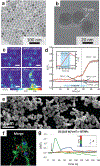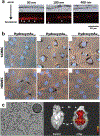Neuro-Nano Interfaces: Utilizing Nano-Coatings and Nanoparticles to Enable Next-Generation Electrophysiological Recording, Neural Stimulation, and Biochemical Modulation
- PMID: 33867903
- PMCID: PMC8049593
- DOI: 10.1002/adfm.201700239
Neuro-Nano Interfaces: Utilizing Nano-Coatings and Nanoparticles to Enable Next-Generation Electrophysiological Recording, Neural Stimulation, and Biochemical Modulation
Abstract
Neural interfaces provide a window into the workings of the nervous system-enabling both biosignal recording and modulation. Traditionally, neural interfaces have been restricted to implanted electrodes to record or modulate electrical activity of the nervous system. Although these electrode systems are both mechanically and operationally robust, they have limited utility due to the resultant macroscale damage from invasive implantation. For this reason, novel nanomaterials are being investigated to enable new strategies to chronically interact with the nervous system at both the cellular and network level. In this feature article, the use of nanomaterials to improve current electrophysiological interfaces, as well as enable new nano-interfaces to modulate neural activity via alternative mechanisms, such as remote transduction of electromagnetic fields are explored. Specifically, this article will review the current use of nanoparticle coatings to enhance electrode function, then an analysis of the cutting-edge, targeted nanoparticle technologies being utilized to interface with both the electrophysiological and biochemical behavior of the nervous system will be provided. Furthermore, an emerging, specialized-use case for neural interfaces will be presented: the modulation of the blood-brain barrier.
Keywords: blood-brain barrier; brain; nanoparticle; neural interface; neurostimulation.
Conflict of interest statement
Conflict of Interest The authors declare no conflict of interest.
Figures












Similar articles
-
Multifunctional Nanomaterials for Advancing Neural Interfaces: Recording, Stimulation, and Beyond.Acc Chem Res. 2024 Jul 2;57(13):1803-1814. doi: 10.1021/acs.accounts.4c00138. Epub 2024 Jun 10. Acc Chem Res. 2024. PMID: 38859612 Free PMC article. Review.
-
Micro- and nanotechnology for neural electrode-tissue interfaces.Biosens Bioelectron. 2020 Dec 15;170:112645. doi: 10.1016/j.bios.2020.112645. Epub 2020 Sep 25. Biosens Bioelectron. 2020. PMID: 33010703 Review.
-
Optimizing the neuron-electrode interface for chronic bioelectronic interfacing.Neurosurg Focus. 2020 Jul;49(1):E7. doi: 10.3171/2020.4.FOCUS20178. Neurosurg Focus. 2020. PMID: 32610294
-
Implantable neurotechnologies: a review of micro- and nanoelectrodes for neural recording.Med Biol Eng Comput. 2016 Jan;54(1):23-44. doi: 10.1007/s11517-015-1430-4. Epub 2016 Jan 11. Med Biol Eng Comput. 2016. PMID: 26753777 Review.
-
Monolithically Defined Wireless Fully Implantable Nervous System Interfaces.Acc Chem Res. 2024 May 7;57(9):1275-1286. doi: 10.1021/acs.accounts.4c00013. Epub 2024 Apr 12. Acc Chem Res. 2024. PMID: 38608256
Cited by
-
Noble metal sensitized invasive porous bioelectrodes: advanced medical device for enhanced neuronal activity and chronic alcohol treatment.RSC Adv. 2020 Dec 9;10(71):43514-43522. doi: 10.1039/d0ra07922g. eCollection 2020 Nov 27. RSC Adv. 2020. PMID: 35519706 Free PMC article.
-
Development of Neuronal Guidance Fibers for Stimulating Electrodes: Basic Construction and Delivery of a Growth Factor.Front Bioeng Biotechnol. 2022 Jan 24;10:776890. doi: 10.3389/fbioe.2022.776890. eCollection 2022. Front Bioeng Biotechnol. 2022. PMID: 35141211 Free PMC article.
-
Tumor diagnosis using carbon-based quantum dots: Detection based on the hallmarks of cancer.Bioact Mater. 2023 Nov 15;33:174-222. doi: 10.1016/j.bioactmat.2023.10.004. eCollection 2024 Mar. Bioact Mater. 2023. PMID: 38034499 Free PMC article. Review.
-
Improving the Biocompatibility and Functionality of Neural Interface Devices with Silica Nanoparticles.Acc Chem Res. 2024 Jun 18;57(12):1684-1695. doi: 10.1021/acs.accounts.4c00160. Epub 2024 May 30. Acc Chem Res. 2024. PMID: 38814586 Free PMC article.
-
Interfacing with the Brain: How Nanotechnology Can Contribute.ACS Nano. 2025 Mar 25;19(11):10630-10717. doi: 10.1021/acsnano.4c10525. Epub 2025 Mar 10. ACS Nano. 2025. PMID: 40063703 Free PMC article. Review.
References
Grants and funding
LinkOut - more resources
Full Text Sources
Other Literature Sources
